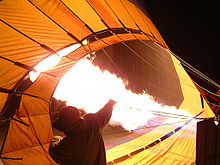Hot air ballooning
The first clearly recorded instance of a balloon carrying passengers used hot air to generate buoyancy and was built by the brothers Joseph-Michel and Jacques-Etienne Montgolfier in Annonay, France.
After experimenting with unmanned balloons and flights with animals, the first tethered balloon flight with humans on board took place on October 19, 1783, with the scientist Jean-François Pilâtre de Rozier, the manufacture manager, Jean-Baptiste Réveillon and Giroud de Villette, at the Folie Titon in Paris.
[1] King Louis XVI had originally decreed that condemned criminals would be the first pilots, but de Rozier, along with Marquis Francois d'Arlandes, successfully petitioned for the honor.
According to the FAA's General Aviation Survey data, in 2012, there were about 2,300 personally owned and flown balloons, and about 495 commercial sightseeing ride operators in the United States.
On November 26, 2005, Vijaypat Singhania set the world altitude record for highest hot air balloon flight, reaching 21,290 meters (69,850 feet).
However, as with all unpressurised aircraft, oxygen is needed for all crew and passengers on any balloon flight that reaches and exceeds an altitude of 3,810 meters (12,500 feet).
With a volume of 74,000 m3 (2,600,000 cu ft), the balloon envelope was the largest ever built for a hot air craft.
Designed to fly in the trans-oceanic jetstreams the Pacific Flyer recorded the highest ground speed for a manned balloon of 245 mph (394 km/h).
[citation needed] The distance record was broken on March 21, 1999, when the Breitling Orbiter 3 carrying Bertrand Piccard and Brian Jones touched down in Egypt, having circumnavigated the globe and set records for duration (19 days, 21 hours and 55 minutes) and distance (46,759 km).
Flying at these times also avoids thermals, which are vertical air currents caused by ground heating that make it more difficult to control the balloon.
Before a safe hot air balloon flight can begin, the pilot must check the weather and select a suitable take-off point.
The take-off point must be large enough to lay out and inflate the envelope and clear of obstructions such as power lines and poles, trees, and buildings to allow lift-off under the predicted wind conditions.
Finally, the take-off point must be situated such that the predicted winds will move the balloon in the direction of suitable landing sites.
Another way to determine actual wind directions is to watch other hot air balloons, which are the equivalent of a large met-balloon.
The direction of flight depends on the wind, but the altitude of the balloon can be controlled by changing the temperature of the air inside the envelope.
The goal of the pilot is to light the burner at the right interval and for the right duration (a few seconds) to keep the balloon slowly drifting up and down about the desired altitude.
A pickup truck or van by itself can be more maneuverable but at the cost of squeezing all the equipment, crew, pilot, and passengers into a single vehicle.
The use of cell phones for this purpose, while the balloon is flying, may violate local telecommunication laws and should therefore be avoided except in an emergency situation.
If the balloon is moving at this speed or more when it contacts the ground, the basket (which usually does not have wheels of any kind on the bottom) may drag for a bit or even tip over.
Pilots can improve the situation by landing in a spot protected from the wind, such as behind a line of trees or in a small valley.
Once a pilot has directed the balloon as close as possible to a target, a weighted marker with an identifying number written on it is dropped.
After a set amount of flight time, the Hare will land and typically lay out a target cross for the Hounds to drop their weighted markers near.
The dangers of the sport include excessive (vertical or horizontal) speed during landing, mid-air collisions that may collapse the balloon, and colliding with high voltage power lines.
However, if the liquid propane in the fuel tanks is too cold (0 °C [ 32 °F ]/ or less) it does not generate sufficient vapor pressure to adequately feed the burner(s).
This can be overcome by charging the fuel tanks with inert gas such as nitrogen[12] or by warming them, with electric heat tapes for example, and insulating them against the cold.
While typical day flights use the main valve, using an efficient blue flame, at night tethered pilots use the liquid valve "whisper burner" ("cow burner", as it does not startle livestock), creating a spectacular bright orange flame.










